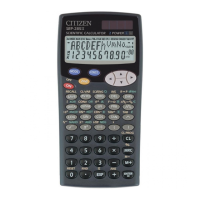
Do you have a question about the Citizen SRP-285II and is the answer not in the manual?
| Brand | Citizen |
|---|---|
| Model | SRP-285II |
| Category | Calculator |
| Language | English |
Instructions for powering the calculator on and off using dedicated keys.
Steps for replacing the calculator's battery and solar cell.
Explanation of the automatic power-off feature and reactivation.
Procedure to reset the calculator and clear memory contents.
How to adjust the display contrast using mode keys.
Details on the display components: entry line, result line, and indicators.
Guide on selecting one of the six operating modes.
How to navigate and select options from on-screen menus.
Instructions on accessing secondary functions marked in yellow.
How to move the cursor for editing entries and navigating the display.
Methods for deleting, replacing, and inserting characters during input.
Functionality for storing and recalling previous operations for editing.
How the calculator indicates the position of mathematical errors.
Operations for adding, subtracting, and recalling values from memory.
Explanation of the precedence rules for mathematical calculations.
Details on the calculator's output digits, calculating digits, and input ranges.
List of error messages and the conditions that cause them.
Changing and converting between DEG, RAD, and GRAD angle units.
Using standard and inverse trigonometric functions (sin, cos, tan).
Calculating hyperbolic and inverse hyperbolic functions (sinh, cosh, tanh).
Converting between rectangular and polar coordinates.
Using probability functions like nPr, nCr, factorial, and random number generation.
Accessing reciprocal, square root, square, and exponentiation functions.
Converting numbers between metric and English units across various categories.
Listing and using physical constants in calculations.
Performing basic arithmetic operations and handling negative numbers.
Setting decimal places and choosing between floating, scientific, and engineering formats.
How to use parentheses for complex calculations and their precedence.
Using the percentage function for calculations like add-ons and discounts.
Repeating the last operation or using the previous result for further calculations.
Storing and recalling the most recent calculation result.
Calculating common and natural logarithms and anti-logarithms.
Entering and displaying fractions, including mixed numbers and improper fractions.
Inputting and analyzing single or paired datasets for statistics.
Calculating capability indices like Cax, Cay, Cpx, Cpy, Cpkx, Cpky.
Calculating probability distribution variables like t, P(t), R(t), Q(t).
Performing linear regression analysis and predicting values.
Modifying entered data, limits, or frequencies within statistical modes.
Converting numbers between decimal, binary, octal, and hexadecimal bases.
How negative numbers are represented in binary, octal, and hexadecimal bases.
Performing addition, subtraction, multiplication, and division in non-decimal bases.
Executing logical operations like AND, OR, XOR, NOT.
Performing arithmetic operations on complex numbers.
Using VLE mode to solve systems of linear equations with two unknowns.
Using QE mode to solve quadratic equations of the form ax²+bx+c=0.
